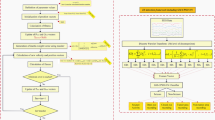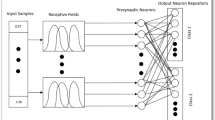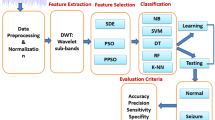Abstract
In order to improve the modeling performance of Volterra sequence for nonlinear neural activity, in this paper, a new optimization algorithm is proposed to identify Volterra sequence parameters. Algorithm combines the advantages of particle swarm optimization (PSO) and genetic algorithm (GA) improve the performance of the identification of nonlinear model parameters from rapidity and accuracy. In the modeling experiments of neural signal data generated by the neural computing model and clinical neural data set in this paper, the proposed algorithm shows its excellent potential in nonlinear neural activity modeling. Compared with PSO and GA, the algorithm can achieve less identification error, and better balance the convergence speed and identification error. Further, we explore the influence of algorithm parameters on identification efficiency, which provides possible guiding significance for parameter setting in practical application of the algorithm.












Similar content being viewed by others
Data availability
Data sharing not applicable to this article as no datasets were generated or analyzed during the current study.
References
Abbas HM, Bayoumi MM (2004) Volterra system identification using adaptive genetic algorithms. Appl Soft Comput 5:75–86
Abbas HM, Bayoumi MM (2006) Volterra-system identification using adaptive real-coded genetic algorithm. IEEE Trans Syst Man Cybern Paart A-Syst Hum 36:671–684
Abbaspourazad H, Hsieh H-L, Shanechi MM (2019) A multiscale dynamical modeling and identification framework for spike-field activity. IEEE Trans Neural Syst Rehabil Eng 27:1128–1138
Altun AA (2013) A combination of genetic algorithm, particle swarm optimization and neural network for palmprint recognition. Neural Comput & Applic 22:27–33
Baker CTH (2000) A perspective on the numerical treatment of Volterra equations. J Comput Appl Math 125:217–249
Benuwa B-B, Ghansah B, Wornyo DK, Adabunu SA (2016) A comprehensive review of particle swarm optimization. Int J Eng Res Afr 23:141–161
Berger TW, Song D, Chan RHM, Marmarelis VZ, LaCoss J, Wills J, Hampson RE, Deadwyler SA, Granacki JJ (2012) A hippocampal cognitive prosthesis: multi-input, multi-output nonlinear modeling and VLSI implementation. IEEE Trans Neural Syst Rehabil Eng 20:198–211
Chakravarthy VS, Moustafa AA (2018) Computational neuroscience models of the basal ganglia. Springer Singapore, Singapore
Chang S, Wei X, Su F, Liu C, Yi G, Wang J, Han C, Che Y (2020) Model predictive control for seizure suppression based on nonlinear auto-regressive moving-average volterra model. IEEE Trans Neural Syst Rehabil Eng 28:2173–2183
de Paula NCG, Marques FD (2019) Multi-variable volterra kernels identification using time-delay neural networks: application to unsteady aerodynamic loading. Nonlinear Dyn 97:767–780
Du M, Li J, Ying W, Yu Y (2022) A dynamics model of neuron-astrocyte network accounting for febrile seizures. Cogn. Neurodynamics
Eikenberry SE, Marmarelis VZ (2013) A nonlinear autoregressive Volterra model of the Hodgkin-Huxley equations. J Comput Neurosci 34:163–183
Fei Su, Kumaravelu K, Wang J, Warren M (2019) Grill model-based evaluation of closed-loop deep brain stimulation controller to adapt to dynamic changes in reference signal. Front Neurosci 13:956
Friston KJ (2001) Brain function, nonlinear coupling, and neuronal transients. Neuroscientist 7:406–418
Goldberger AL, Amaral LA, Glass L, Hausdorff JM, Ivanov PC, Mark RG, Mietus JE, Moody GB, Peng CK, Stanley HE (2000) PhysioBank, physiotoolkit, and physionet: components of a new research resource for complex physiologic signals. Circulation 101:215–220
Gong Y-J, Li J-J, Zhou Y, Li Y, Chung HS-H, Shi Y-H, Zhang J (2016) Genetic learning particle swarm optimization. IEEE t Cybern 46:2277–2290
He F, Yang Y (2021) Nonlinear system identification of neural systems from neurophysiological signals. Neuroscience 458:213–228
Hu B, Wang Z, Xu M, Zhang D, Wang D (2022) The adjustment mechanism of the spike and wave discharges in thalamic neurons: a simulation analysis. Cogn. Neurodynamics
Jordehi AR (2014) Particle swarm optimisation for dynamic optimisation problems: a review. Neural Comput Appl 25:1507–1516
Lind R, Prazenica RJ, Brenner MJ (2013) Estimating nonlinearity using volterra kernels in feedback with linear models. Nonlinear Dyn 39(1–2):3–23
Liu C, Wang J, Li H, Lu M, Deng B, Yu H, Wei X, Fietkiewicz C, Loparo KA (2017) Closed-Loop Modulation of the Pathological Disorders of the Basal Ganglia Network. IEEE Tran Neural Net Learn Syst 28:371–382
Lytton WW (2008) Computer modelling of epilepsy. Nat Rev Neurosci 9:626–637
Meruelo AC, Simpson DM, Veres SM, Newland PL (2016) Improved system identification using artificial neural networks and analysis of individual differences in responses of an identified neuron. Neural Netw 75:56–65
Millard DC, Wang Q, Gollnick CA, Stanley GB (2013) System identification of the nonlinear dynamics in the thalamocortical circuit in response to patterned thalamic microstimulation in vivo. J Neural Eng 10:066011
Quaranta G, Lacarbonara W, Masri SF (2020) A review on computational intelligence for identification of nonlinear dynamical systems. Nonlinear Dyn 99:1709–1761
Silva W (2005) Identification of nonlinear aeroelastic systems based on the volterra theory: progress and opportunities. Nonlinear Dyn 39:25–62
Song D, Chan RHM, Marmarelis VZ, Hampson RE, Deadwyler SA, Berger TW (2007) Nonlinear dynamic modeling of spike train transformations for hippocampal-cortical prostheses. IEEE Trans Biomed Eng 54:1053–1066
Stanley GB (2003) Neural System Identification. Springer, US
Stefanescu RA, Shivakeshavan RG, Talathi SS (2012) Computational models of epilepsy. Seizure-Eur J Epilepsy 21:748–759
Su F, Wang J, Niu S, Li H, Deng B, Liu C, Wei X (2018) Nonlinear predictive control for adaptive adjustments of deep brain stimulation parameters in basal ganglia–thalamic network. Neural Netw 98:283–295
Tian R, Yang Y, van der Helm FCT, Dewald JPA (2018) Novel Approach for modeling neural responses to joint perturbations using the NARMAX method and a hierarchical neural network. Front Comput Neurosci 12:96
Vlaar MP, Birpoutsoukis G, Lataire J, Schoukens M, Schouten AC, Schoukens J, van der Helm FCT (2018) Modeling the nonlinear cortical response in EEG evoked by wrist joint manipulation. IEEE Trans Neural Syst Rehabil Eng 26:205–215
Wang H, Li Y, Long J, Yu T, Gu Z (2014) An asynchronous wheelchair control by hybrid EEG-EOG brain-computer interface. Cogn Neurodynamics 8:399–409
Wendling F (2008) Computational models of epileptic activity: a bridge between observation and pathophysiological interpretation. Expert Rev Neurother 8:889–896
Wendling F, Bellanger JJ, Bartolomei F, Chauvel P (2000) Relevance of nonlinear lumped-parameter models in the analysis of depth-EEG epileptic signals. Biol Cybern 83:367–378
Xia X, Zhou J, Xiao J, Xiao H (2016) A novel identification method of Volterra series in rotor-bearing system for fault diagnosis. Mech Syst Signal Proc 66–67:557–567
Xu L, Xu M, Jung T-P, Ming D (2021) Review of brain encoding and decoding mechanisms for EEG-based brain-computer interface. Cogn Neurodynamics 15:569–584
Yang YS, Chang WD, Liao TL (2012) Volterra system-based neural network modeling by particle swarm optimization approach. Neurocomputing 82:179–185
Yang Y, Sani OG, Chang EF, Shanechi MM (2019) Dynamic network modeling and dimensionality reduction for human ECoG activity. J Neural Eng 16:056014
Yu Y, Han F, Wang Q, Wang Q (2022) Model-based optogenetic stimulation to regulate beta oscillations in Parkinsonian neural networks. Cogn. Neurodynamics
Zhao H, Zhang C, Wen L (2018) Maximum likelihood estimation for stochastic lotka-volterra model with jumps. Differ Equ Adv. https://doi.org/10.1186/s13662-018-1605-z
Acknowledgements
This work was supported in part by the National Natural Science Foundation of China (Grant Number: 62173241), the Natural Science Foundation of Tianjin, China (Grant Number: 20JCQNJC01160), the Foundation of Tianjin University (Grant Number: 2020XRG-0018). The authors also gratefully acknowledge the financial support provided by Opening Foundation of Key Laboratory of Opto-technology and Intelligent Control (Lanzhou Jiaotong University), Ministry of Education (KFKT2020-01).
Funding
National Natural Science Foundation of China,62173241,Chen Liu,Natural Science Foundation of Tianjin City,20JCQNJC01160,Chen Liu, Foundation of Tianjin University, 2020XRG-0018,Chen Liu, Opening Foundation of Key Laboratory of Opto-technology and Intelligent Control (Lanzhou Jiaotong University), Ministry of Education, KFKT2020-01, Chen Liu
Author information
Authors and Affiliations
Corresponding author
Ethics declarations
Conflict of interest
We declare that we have no financial and personal relationships with other people or organizations that can inappropriately influence our work, there is no professional or other personal interest of any nature or kind in any product, service and/or company that could be construed as influencing the position presented in.
Additional information
Publisher's Note
Springer Nature remains neutral with regard to jurisdictional claims in published maps and institutional affiliations.
Rights and permissions
About this article
Cite this article
Chang, S., Wang, J., Zhu, Y. et al. Nonlinear dynamical modeling of neural activity using volterra series with GA-enhanced particle swarm optimization algorithm. Cogn Neurodyn 17, 467–476 (2023). https://doi.org/10.1007/s11571-022-09822-1
Received:
Revised:
Accepted:
Published:
Issue Date:
DOI: https://doi.org/10.1007/s11571-022-09822-1




